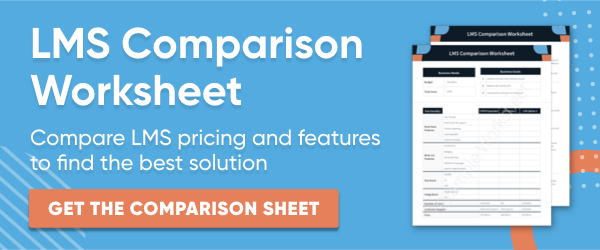More and more, large organizations are finding that their existing learning management systems aren’t meeting business needs. Larger organizations are more likely to be early adopters of LMS technology, so the systems currently in use may not include the updated features and capabilities that are available with newer systems – BYOD support, for example. Or the company may have gone through a period of rapid growth, adding employees, customers, and training courses to the system that cause an LMS that was appropriate tin the past to not meet the needs of a large organization today.
A recent survey¹ found that 26 percent of enterprises are either dissatisfied or very dissatisfied with their current learning management system. The top reasons² why organizations aren’t satisfied with their LMS include:
- Poor user experience (88%)
- Poor administrative interface (74%)
- Poor reporting (66%)
- Lack of integrations (66%)
- Lack of mobile capabilities (66%)
Brandon Hall found that nearly half of organizations surveyed³ are considering switching to an LMS that provides the eLearning features and capabilities their existing systems lack. But switching LMS systems is rarely fast and almost never easy, especially for large enterprises. And if done improperly, switching systems can put you in an even worse place than you were before.
Before making on a final decision on whether or not you should switch to a new LMS, here are four things you need to know.
1. You Need a Solid Reason
You may not be entirely happy with the user experience in your current LMS, but is that a good enough reason to switch? Not necessarily. To make a switch worthwhile, you need solid reasons that impact your business.
When evaluating your reasons for wanting to change LMS systems, the first thing to consider is how a new LMS will be used by your business. What’s the current problem and how is it affecting your company? If user experience is the issue, are your employees or customers so frustrated that they won’t complete training courses? That could cause a major negative impact on your internal productivity and customer satisfaction, which is a good reason to make a change.
Once you’ve nailed down current problems, rephrase them into what you’re hoping to get out of the new system. What are the goals of the change, and how will a new system help reach training and development goals, as well as strategic organizational objectives? Include your assessment of the major pain points of the existing system to ensure that the selection process addresses current issues directly.
2. Switching LMS Systems Could Be More Expensive than You Anticipate
Cost is always a major consideration in enterprise decisions, and a proposal to change from one vendor to another should always include a cost-benefit discussion. Since there are a variety of LMS pricing models, an organization must have a clear picture of how it will be used in order to accurately evaluate the cost of different solutions.
For example, a per-learner or per-course system may be cost-effective for a small business, but cost-prohibitive for a large enterprise. Instead, a big business may find that a fixed annual subscription that offers unlimited students and courses is not only less expensive, but also easier for accounting, budgeting and forecasting.
The price tag of your new LMS also isn’t the only cost you need to consider. When switching LMS systems, you may also need to make additional financial investments in data migration, custom integrations, setup, and system training. Some LMS companies include these costs in their price, but many don’t.
Finally, your team needs to be aware of the non-monetary costs of switching your LMS. Migrating a large company to a new system almost always requires significant time and staff resources. You need time and staff to audit the data, content, and reports in your current system, determine what needs to stay, what you can purge, and the best way to move data to your new system.
3. A Change Management Plan is Essential
An estimated4 70% of organizational change initiatives fail, so it is important to lay the groundwork for a successful LMS transition. A successful change management plan includes communication, executive-level support, as well as appointing ‘change champions’ throughout the organization to help drive success.
To successful switch to a new LMS system, you need to develop a change management plan that ensures key stakeholders are on board and that end users (whether you’re training employees, customers, or contractors) understand and adopt the new system. Without an effective change management plan, you’re far more likely to invest a significant amount of resources into an initiative that doesn’t get results for your business.
4. Migration is Rarely Straightforward
Once a new system is selected, a realistic, step-by-step plan must be created to change over to a new system. It is critical to understand the technology requirements of the new LMS, to ensure that the enterprise IT team is brought in early in the process, and to delineate the vendor management and support that will be available throughout. Key points to consider are:
- Timeline: how long will it take to get the new system up and running?
- Technology: can existing infrastructure support the new LMS?
- Support: how involved and available are vendors in the process?
- Training: when and how will employees be trained to use the new system?
As experienced IT staff are well aware, migrating to a new system usually includes a few bumps in the road. Data might not move over as smoothly as you anticipate. End users could take longer to get up to speed on the new system. Integrations may not work the way you want the first time. Build in time to identify and address these issues so you don’t create unrealistic expectations, put extra stress on your team, or cause unnecessary disruption.
An organization-wide implementation that causes disruption will generate negative feelings about the application before it is even available for use. However, a clear, realistic migration plan can absorb issues, minimizing disruption and improving perception of the new system.
Switching LMS Systems is Often a Bumpy Road, But Can Have Major Business Benefits
Changing LMS systems, especially in a large organization, is a complicated undertaking that requires a great deal of investigation, planning, and proactive change management to ensure success. However, finding the right LMS can have significant benefits for large companies.
Not only does an LMS offer the opportunity for quick, efficient information distribution, it may also contribute to improving employee retention, educating customers, closing skills gaps, and implementing effective succession planning. The best learning management systems can even have a direct impact on your bottom line.
Resources:
1https://www.capterra.com/learning-management-system-software/user-research 2https://www.ispringsolutions.com/blog/top-lms-industry-facts-of-2016
3https://axonify.com/blog/44-companies-considering-replacing-lms/
4https://www.forbes.com/sites/brentgleeson/2017/07/25/1-reason-why-most-change-management-efforts-fail/#46bf0de3546b






